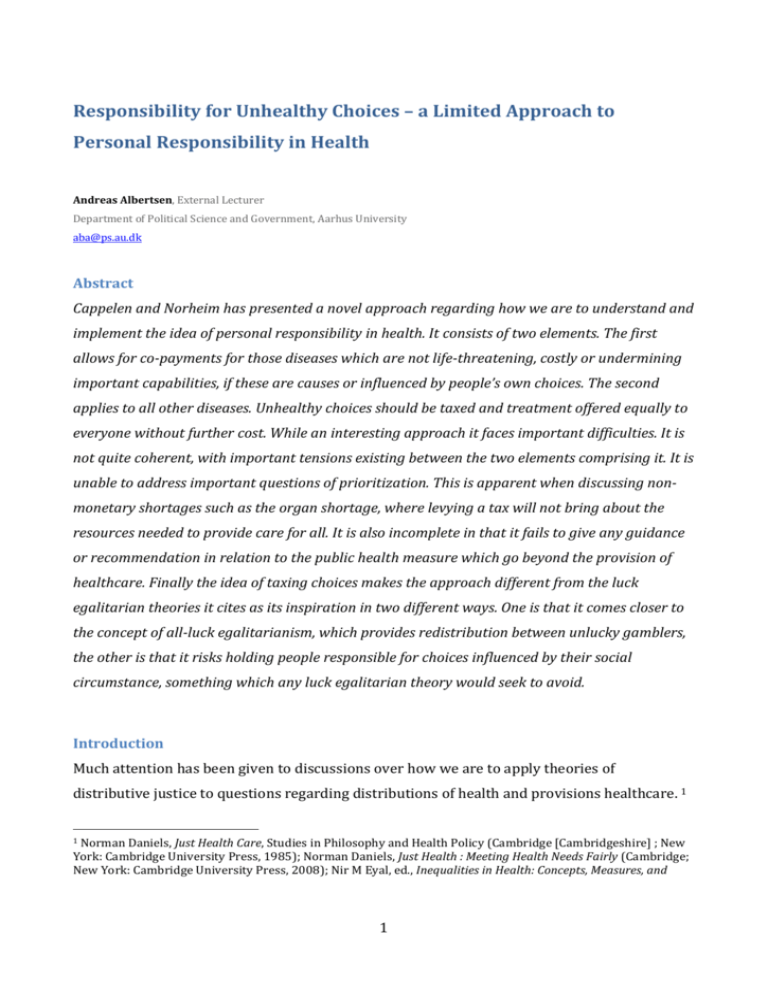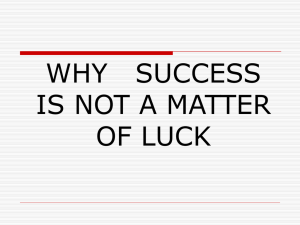a Limited Approach to Personal Responsibility in Health
advertisement

Responsibility for Unhealthy Choices – a Limited Approach to Personal Responsibility in Health Andreas Albertsen, External Lecturer Department of Political Science and Government, Aarhus University aba@ps.au.dk Abstract Cappelen and Norheim has presented a novel approach regarding how we are to understand and implement the idea of personal responsibility in health. It consists of two elements. The first allows for co-payments for those diseases which are not life-threatening, costly or undermining important capabilities, if these are causes or influenced by people’s own choices. The second applies to all other diseases. Unhealthy choices should be taxed and treatment offered equally to everyone without further cost. While an interesting approach it faces important difficulties. It is not quite coherent, with important tensions existing between the two elements comprising it. It is unable to address important questions of prioritization. This is apparent when discussing nonmonetary shortages such as the organ shortage, where levying a tax will not bring about the resources needed to provide care for all. It is also incomplete in that it fails to give any guidance or recommendation in relation to the public health measure which go beyond the provision of healthcare. Finally the idea of taxing choices makes the approach different from the luck egalitarian theories it cites as its inspiration in two different ways. One is that it comes closer to the concept of all-luck egalitarianism, which provides redistribution between unlucky gamblers, the other is that it risks holding people responsible for choices influenced by their social circumstance, something which any luck egalitarian theory would seek to avoid. Introduction Much attention has been given to discussions over how we are to apply theories of distributive justice to questions regarding distributions of health and provisions healthcare. 1 Norman Daniels, Just Health Care, Studies in Philosophy and Health Policy (Cambridge [Cambridgeshire] ; New York: Cambridge University Press, 1985); Norman Daniels, Just Health : Meeting Health Needs Fairly (Cambridge; New York: Cambridge University Press, 2008); Nir M Eyal, ed., Inequalities in Health: Concepts, Measures, and 1 1 Of special interest has been the debate over how to apply luck egalitarianism to such discussions. 2 Roughly stated, luck egalitarianism expresses the idea that distributions are just, if and only if, people’s relative positions reflect their exercises of responsibility. 3 The interest in whether luck egalitarianism yields plausible conclusions in the context of health is likely to be connected with the fact that it is an influential and much discussed theory over distributive justice. 4 But it may also be because the theory connects with an idea influential in much academic and political discussion, namely that we are allowed to give lower priority to those who can be said to be responsible for their own medical needs. 5 Considering the Ethics (Oxford: Oxford University Press, 2013); Jennifer Prah Ruger, Health and Social Justice (Oxford ; New York: Oxford University Press, 2010); Shlomi Segall, Health, Luck, and Justice (Princeton, NJ: Princeton, 2010); Amartya Sen, “Why Health Equity?,” Health Economics 11, no. 8 (December 2002): 659–66, doi:10.1002/hec.762; Sridhar Venkatapuram, Health justice (Cambridge: Polity Press, 2011); Sridhar Venkatapuram and Michael Marmot, “Epidemiology and Social Justice in Light of Social Determinants of Health Research,” Bioethics 23, no. 2 (February 2009): 79–89, doi:10.1111/j.1467-8519.2008.00714.x. 2 Author, “Author’s Publication,” n.d.; Julian Le Grand, “Individual Responsibility, Health, and Health Care,” in Inequalities in Health: Concepts, Measures, and Ethics, ed. Nir Eyal et al., Population-Level Bioethics Series (Oxford: Oxford University Press, 2013), 299–306; Shlomi Segall, “In Solidarity with the Imprudent: A Defense of Luck Egalitarianism,” Social Theory and Practice 33, no. 2 (2007): 177–98; Segall, Health, Luck, and Justice; Kristin Voigt, “Appeals to Individual Responsibility for Health,” Cambridge Quarterly of Healthcare Ethics 22, no. 02 (March 14, 2013): 146–58, doi:10.1017/S0963180112000527. 3 Kasper Lippert-Rasmussen, “Arneson on Equality of Opportunity for Welfare,” Journal of Political Philosophy 7, no. 4 (1999): 478–87, doi:10.1111/1467-9760.00087. 4 Richard J. Arneson, “Luck Egalitarianism Interpreted and Defended,” Philosophical Topics 32, no. 1/2 (2004): 1– 20; Richard J. Arneson, “Luck Egalitarianism - A Primer,” in Responsibility and Distributive Justice, ed. Carl Knight and Zofia Stemplowska (Oxford; New York: Oxford University Press, 2011), 24–50; Carl Knight, Luck Egalitarianism (Edinburgh: Edinburgh University Press, 2009); Zofia Stemplowska, “Rescuing Luck Egalitarianism,” Journal of Social Philosophy 44, no. 4 (December 2013): 402–19, doi:10.1111/josp.12039. 5 Gene Bishop and Amy C. Brodkey, “Personal Responsibility and Physician Responsibility — West Virginia’s Medicaid Plan,” New England Journal of Medicine 355, no. 8 (August 24, 2006): 756–58, doi:10.1056/NEJMp068170; Alexander Brown, “If We Value Individual Responsibility, Which Policies Should We Favour?,” Journal of Applied Philosophy 22, no. 1 (March 2005): 23–44, doi:10.1111/j.1468-5930.2005.00290.x; Alexander Brown, Personal Responsibility: Why It Matters, Think Now (London ; New York: Continuum, 2009); Nir Eyal, “Denial of Treatment to Obese Patients—the Wrong Policy on Personal Responsibility for Health,” International Journal of Health Policy and Management 1, no. 2 (2013): 107–10, doi:10.15171/ijhpm.2013.18; Department of Health, “Choosing Health: Making Healthy Choices Easier,” 2004; O. Golan, “The Right to Treatment for Self-Inflicted Conditions,” Journal of Medical Ethics 36, no. 11 (August 16, 2010): 683–86, doi:10.1136/jme.2010.036525; Julian Le Grand, Equity and Choice an Essay in Economics and Applied Philosophy (London ;;New York, NY, USA : HarperCollins Academic, 1991); Howard M. Leichter, “‘Evil Habits’ and ‘Personal Choices’: Assigning Responsibility for Health in the 20th Century,” The Milbank Quarterly 81, no. 4 (January 1, 2003): 603–26; M. Minkler, “Personal Responsibility for Health? A Review of the Arguments and the Evidence at Century’s End,” Health Education & Behavior 26, no. 1 (February 1, 1999): 121–41, doi:10.1177/109019819902600110; M. Minkler, “Personal Responsibility for Health: Contexts and Controversies,” in Promoting Healthy Behavior : How Much Freedom? Whose Responsibility?, ed. Daniel Callahan (Washington, D.C.: Georgetown University Press, 2000); S J Reiser, “Responsibility for Personal Health: A Historical Perspective,” The Journal of Medicine and Philosophy 10, no. 1 (February 1985): 7–17; Harald Schmidt, “Bonuses as Incentives and Rewards for Health Responsibility: A Good Thing?,” Journal of Medicine and Philosophy 33, no. 3 (June 1, 2008): 198–220, doi:10.1093/jmp/jhn007; Harald Schmidt, “Personal Responsibility in the NHS Constitution and the Social Determinants of Health Approach: Competitive or 2 strengths and weaknesses of luck egalitarianism in this context has led many to the conclusion, that the implications of the general theory in this context reflects badly on the theory as such and thus, on attempts to make allocation of healthcare attentive to personal responsibility. 6 This has prompted several interesting attempts to restate luck egalitarianism in health, in a way which is able to provide answers to recurrent criticism. This article critically engages with one specific way of dealing whit this critique, which has receive much attention, namely the ‘liberal egalitarian approach proposed by Cappelen and Norheim. 7 This article presents their approach and points to some difficulties and ambiguities within it. Complementary?,” Health Economics, Policy and Law 4, no. 02 (March 9, 2009): 129, doi:10.1017/S1744133109004976; Kerith Sharkey and Lynn Gillam, “Should Patients with Self-Inflicted Illness Receive Lower Priority in Access to Healthcare Resources? Mapping out the Debate,” Journal of Medical Ethics 36, no. 11 (November 2010): 661–65, doi:10.1136/jme.2009.032102; Lance K. Stell, “Responsibility for Health Status,” in Medicine and Social Justice: Essays on the Distribution of Health Care, ed. Rosamond Rhodes, M. Pabst Battin, and Anita Silvers (Oxford ; New York: Oxford University Press, 2002); Gustav Tinghőg, Per Carlsson, and Carl H. Lyttkens, “Individual Responsibility for What? – A Conceptual Framework for Exploring the Suitability of Private Financing in a Publicly Funded Health-Care System,” Health Economics, Policy and Law 5, no. 02 (2010): 201–23, doi:10.1017/S174413310999017X; Peter A. Ubel, Jonathan Baron, and David A. Asch, “Social Acceptability, Personal Responsibility, and Prognosis in Public Judgments and Transplant Allocation,” Bioethics 13, no. 1 (January 1999): 57–68, doi:10.1111/1467-8519.00131; R M Veatch and P Steinfels, “If National Health Insurance Is Enacted--Who Should Pay for Smokers’ Medical Care?,” The Hastings Center Report 4, no. 5 (November 1974): 8–10; Daniel Wikler, “Personal and Social Responsibility for Health,” in Public Health, Ethics, and Equity, ed. Sudhir Anand, Fabienne Peter, and Amartya Sen (Oxford; New York: Oxford University Press, 2004), 109–35. 6 R. C. H. Brown, “Moral Responsibility for (un)healthy Behaviour,” Journal of Medical Ethics, January 11, 2013, doi:10.1136/medethics-2012-100774; A M Buyx, “Personal Responsibility for Health as a Rationing Criterion: Why We Don’t like It and Why Maybe We Should,” Journal of Medical Ethics 34, no. 12 (December 1, 2008): 871– 74, doi:10.1136/jme.2007.024059; A. Buyx and B. Prainsack, “Lifestyle-Related Diseases and Individual Responsibility through the Prism of Solidarity,” Clinical Ethics 7, no. 2 (July 19, 2012): 79–85, doi:10.1258/ce.2012.012008; Norman Daniels, “Individual and Social Responsibility for Health,” in Responsibility and Distributive Justice, ed. Carl Knight and Zofia Stemplowska (Oxford; New York: Oxford University Press, 2011), 266–86; E Feiring, “Lifestyle, Responsibility and Justice,” Journal of Medical Ethics 34, no. 1 (January 1, 2008): 33–36, doi:10.1136/jme.2006.019067; Leonard M. Fleck, “Whoopie Pies, Supersized Fries,” Cambridge Quarterly of Healthcare Ethics 21, no. 01 (December 13, 2011): 5–19, doi:10.1017/S0963180111000454; Daniel M. Hausman, “Egalitarian Critiques of Health Inequalities,” in Inequalities in Health: Concepts, Measures, and Ethics, ed. Nir Eyal et al., Population-Level Bioethics Series (Oxford: Oxford University Press, 2013), 95–112; Lasse Nielsen, “Taking Health Needs Seriously: Against a Luck Egalitarian Approach to Justice in Health,” Medicine, Health Care and Philosophy 16, no. 3 (August 2013): 407–16, doi:10.1007/s11019-012-9399-3; Lasse Nielsen and David V. Axelsen, “Three Strikes Out: Objections to Shlomi Segall’s Luck Egalitarian Justice in Health,” Ethical Perspectives 19, no. II (2012): 307–16; Venkatapuram, Health justice; Wikler, “Personal and Social Responsibility for Health.” 7 Alexander W. Cappelen and Ole Frithjof Norheim, “Responsibility in Health Care: A Liberal Egalitarian Approach,” Journal of Medical Ethics 31 (2005): 476–80, doi:10.1136/jme.2004.010421; Alexander W. Cappelen and Ole Frithjof Norheim, “Responsibility, Fairness and Rationing in Health Care,” Health Policy 76, no. 3 (2006): 312–19, doi:10.1016/j.healthpol.2005.06.013. 3 Cappelan and Norheim’s proposal The authors assess their own proposal as responsibility-sensitive, but not vulnerable to prominent concerns regarding responsibility-sensitive policies in health.8 Their approach consists of two distinct institutional measures, each of which is needed to realize their luck egalitarian, or as they prefer: liberal egalitarian, ambitions. 9 One element involves the taxation of a distinct subset of risky choices, while the other element allows for out-of-pocketpayment on some diseases. Unfortunately the literature has done little to disentangle these two elements, often discussing only the first. 10 The thought driving this article is that a more comprehensive engagement with the authors’ position will help move the debate forward. According to Cappelen and Norheim, the nature of a disease determines which institutional measure we ought to introduce. They distinguish between two subsets of disease and introduce two distinct policy measures applicable to those, both of which are seemingly responsibility-sensitive but in a different fashion. Consider first the element in their approach which has received the least attention. It applies to diseases for which all of the following conditions are met: Not life-threatening Do not limit the use of political rights or exercise of fundamental capabilities Cost of treatment low compared to income 11 Assume that some of the diseases fulfilling those criteria will have been brought about completely or partly as a result of individual behaviour, while others result from factors outside the person’s control. The authors argue that the optimal policy would be to charge actual cost co-payment for those who get such diseases through their own negligence, with the purpose of offering full cover to those who get such diseases for reasons outside their Cappelen and Norheim, “Responsibility in Health Care,” 479; Cappelen and Norheim, “Responsibility, Fairness and Rationing in Health Care,” 315. 9 Cappelen and Norheim, “Responsibility in Health Care,” 478; Cappelen and Norheim, “Responsibility, Fairness and Rationing in Health Care,” 313. 10 Buyx, “Personal Responsibility for Health as a Rationing Criterion”; Feiring, “Lifestyle, Responsibility and Justice”; Harald Schmidt, “Just Health Responsibility,” Journal of Medical Ethics 35, no. 1 (January 1, 2009): 21–26, doi:10.1136/jme.2008.024315; Segall, Health, Luck, and Justice, 47; Nicole A Vincent, “What Do You Mean I Should Take Responsibility for My Own Ill Health?,” Journal of Applied Ethics and Philosophy 1, no. 1 (2009): 39– 51. 11 Cappelen and Norheim, “Responsibility, Fairness and Rationing in Health Care,” 315. 8 4 control. 12 They illustrate their approach by comparing two groups with different diseases. In one group all are sick for reasons unrelated to behaviour, in the other it’s a mix of selfinflicted illness and illness from circumstance. Under the assumption that we cannot tell who is responsible in the second group, the authors would favour to charge more from this group than the first. 13 This first element, which allows for introducing co-payments for diseases which are not life-threatening, do not limit political capabilities and where the cost of treatment is low in comparison to the patient’s income, does however not exhaust the role for personal responsibility. The authors explicitly address this subset of diseases because it avoids many common objections to letting personal responsibility affect access to health. The purpose, according to the authors is to whether it is possible to ‘define a limited but significant role for individual responsibility.’ 14 In the same section they mention the approach they believe should be used for all diseases which do not meet the criteria outlined above. This is an important supplement because we can easily imagine diseases where individual choice may contribute to people’s risk of acquiring a low level of health, but where one or more of the conditions outlined above are not met. By definition, the first element of Cappelen and Norheims approach is silent regarding how we are to deal with diseases which are life-threatening, expensive to treat or diminish people’s political capabilities, but where individual choices have contributed to the individual’s poor health. The second however, addresses such questions and the authors maintain that there is room for responsibility-sensitive policies even in those cases. They propose that in such instances we should not hold people responsible for the consequences of their choices (the disease), but rather for the risky choices they’ve made. As their institutional measure for doing this, they propose taxing potentially unhealthy activities to raise money for treating those who fall ill as a consequence of such choices. Each choice will be taxed the same, and no one suffering from such diseases will be further charged for treatment. 15 According to the author’s this idea has a number of advantages compared to introducing responsibility for consequences, co-payment, for this group of diseases as well. The advantage of taxing choices and treating everyone for free is Ibid., 316. Ibid. 14 Ibid., 315. 15 Cappelen and Norheim, “Responsibility in Health Care,” 4792006; Cappelen and Norheim, “Responsibility, Fairness and Rationing in Health Care,” 315. 12 13 5 that it does not let people die from their diseases, suffer severe economic hardship or allow illness to diminish people’s fundamental capabilities. All diseases in this category have, by definition, the potential to do exactly that, but Cappelen and Norheim’s proposal ensures that this does not transpire. They offer another reason, related to luck, for introducing a tax on those choices. They argue that there is an unfairness in people being unequally well off after having made the same choices from a starting point of equality of opportunities. The unfairness, they submit, arises because the difference between the persons is due to luck. 16 Such differences in luck could express ‘different degrees of luck (for example, that the parachute did not open), or different genetic dispositions (for example, a disposition to develop cancer or cardiovascular diseases)’ 17 The liberal egalitarian commitments to eliminate differences in luck, they maintain, would lead us to the view that differences stemming from similar choices should be subject to redistribution. 18 In that regard they suggest that if the outcome of people’s choices were not affected by luck, that is free from influence from other factors, then holding people responsible for their choices and holding people responsible for their circumstances would amount to the same thing. 19 The discussion in the literature is not always attentive to the two distinct elements of the responsibility sensitive proposal from Cappelen and Norheim. One element applying to a certain set of diseases, while the other applies to another. This article unfolds these elements and critically evaluates them, both separately and examined in relation to each other. Three criticisms will be raised in that regard. The first pertains to the coherence of the two elements, the next to the completeness of their framework understood as its ability to deal with important issues. The third evaluates the luck egalitarian credentials of the proposal. Coherence One important thing to discuss is whether the two elements proposed by Cappelen and Norheim can be incorporated into a coherent framework. We can imagine a group of diseases all of which are related to people’s choices. Some of these diseases are expensive to threat Cappelen and Norheim, “Responsibility in Health Care,” 479. Ibid., 477. 18 Ibid., 479. 19 Ibid., 478–479. 16 17 6 (compared to income), life-threatening or undermine political capabilities, others however, do not. On the face of it, it seems quite simple to evaluate which kind of diseases are subject to one institutional measure, and which are subject to the other. Along with the reasoning presented above, we could suggest that regarding the diseases with the mentioned consequences a tax is to be levied on the choice which could result in those diseases. But in their reasoning for holding people responsible for their choices through taxes the authors’ suggest a justification for this scheme which complicates matters. They write that only in instances where people’s health outcome ‘depends solely on the individual’s choices and not on any other factors that this principle implies that individuals should be held responsible for the consequences of their actions.´ 20Thus, one reason to introduce a tax on unhealthy choices is that the severe health outcomes arise out of a complex relationship between choices and luck. This gives rise to a tension, because the authors then seems to suggest both that how to decide between responsibility for consequences and responsibility for choices depends on the nature of the consequences and the degree to which people are responsible. But these considerations may come into conflict. To see how consider a person suffering from a disease which is related to his unhealthy choices, but does not give rise to the serious consequences listed by Cappelen and Norheim. Intuitively, based on the initial description of the authors’ position, we would belief that what matters is the nature of the consequences. As they are, by assumption, not very severe in this case, co-payment seems the appropriate institutional measure to evoke. But could such a person not also claim that he is in the stated sense unlucky that his behaviour leads to a disease? Based on the authors’ own description, this is clearly the case. While the two elements of tax and co-payment in their approach are presented as if they can complement each other, this is seemingly not the case, the authors’ framework lack a ways of deciding which element to prefer when their stated reasons for choosing between them come into conflict. Without such a way of deciding between the two institutional measures we lack the coherence of an applicable framework. Completeness The above section discussed whether the framework has the coherence its authors portray it 20 Ibid. 7 with. This leads to another important discussion, which has to do with whether the framework is complete. Completeness here is to be understood as questions regarding, whether there are important cases to which the framework does not provide any guidance, apart from those of the kind discussed in the previous section. This section raises two issues, for which the approach seemingly provides inadequate answers. One relates to important distributive questions inside the healthcare system, the other to the health policies which go beyond this. Consider first the important questions of prioritizing healthcare resources, which arises due to the shortage of organs. If we have a population of people needing a liver transplant, we could say that those among them who need a liver for reasons related to their past consumption of alcohol are suffering from a disease which has severe consequences. 21 The solution suggested by Cappelen and Norheim’s approach would be to tax the consumption of alcohol and treat everyone who needs a new liver for free, utilizing the funds collected through the tax. But such a solution is incomplete in an important way. While liver transplants are costly the most important resource in this context is not of a monetary kind. 22 The primary shortage is organs. This means that raising extra funds through taxes does not make it possible to treat everyone. The approach proposed by Cappelen and Norheim is thus silent on an important issue, namely that related to shortages of organs. In recent epidemiological discussion, much attention has been given to the concept of social determinants in health.23 The idea is that people’s health and the choices they make to stay healthy is vastly influenced by the places they live, working conditions and socio-economic position. As this literature has been quite influential, much normative literature has tried to incorporate such concerns into their frameworks.24 Often the suggestion is that these findings push us towards considering public health measures, or broader measures to mitigate the influence of social determinants on people’s health. But the approach suggested by Cappelen and Norheim is surprisingly silent on these matters. They don’t have any tools available to incorporate the thought that our health might be unfairly Vibha Varma, Kerry Webb, and Darius F Mirza, “Liver Transplantation for Alcoholic Liver Disease,” World Journal of Gastroenterology 16, no. 35 (2010): 4377–93, doi:10.3748/wjg.v16.i35.4377. 22 in the US for a single transplantation is around $300,000 Tom Koch, Scarce Goods: Justice, Fairness, and Organ Transplantation (Westport, Conn: Praeger, 2002), 7. 23 M. G Marmot and Richard G Wilkinson, Social Determinants of Health (Oxford; New York: Oxford University Press, 2006). 24 Daniels, Just Health; Segall, Health, Luck, and Justice; Venkatapuram and Marmot, “Epidemiology and Social Justice in Light of Social Determinants of Health Research.” 21 8 influenced by social circumstances, at least not beyond providing treatment when we do fall ill. In addition to that, they even seem to allow for levying a tax on choices which could be very influenced by the social conditions in which they are made and the opportunities available to those who are making them. The latter point will also be stressed in the final section. Removing Luck and embracing responsibility The third point to be taken up here, is the extent to which the examined approach reflects the luck egalitarian or liberal egalitarian values. Especially the credentials in that regard of their proposal of taxation of unhealthy choices. This section argues that it overstates the extent to which this reflects the luck egalitarian literature, that it involves too narrow a view on the way in which we can hold people responsible and finally that One thing to note is that the authors overstate how much in line with liberal egalitarianism and luck egalitarianism their position is. This is especially clear with regard to the idea of holding people responsible for their choices. The authors quote Cohen and proceeds as if this idea is clearly in line with his thoughts. They furthermore submit that it is a common ‘misinterpretation…that these theories argue that individuals should be held responsible for the consequences of their choices.’ 25 Most luck egalitarians would find this a puzzling statement. Most, if not all, luck egalitarians does indeed allow for situations, where people are asked to bear the consequences of choices for which they are responsible. 26 If some buy stocks and earns a profit, while others lose money on their investments the goods and burdens flowing from these transactions are not some which luck egalitarianism considers unjust. It would not seem a more likely luck egalitarian scheme to charge each stock an extra premium and use this to compensate those, who fare badly at the stock exchange. Instead of being a straightforward application of luck egalitarianism to health, the cost-sharing scheme proposed by Cappelen and Norheim seems to have much in common with the idea of all luck egalitarianism. The main disagreement between traditional luck egalitarians and all luck egalitarians is whether inequalities stemming from option luck Cappelen and Norheim, “Responsibility in Health Care,” 478. Richard J. Arneson, “Equality and Equal Opportunity for Welfare,” Philosophical Studies 56, no. 1 (1989): 84; G. A. Cohen, “On the Currency of Egalitarian Justice,” Ethics 99, no. 4 (1989): 917; Knight, Luck Egalitarianism; John Roemer, “Equality and Responsibility,” Boston Review 20, no. 2 (1995), http://bostonreview.net/BR20.2/roemer.html; Eric Rakowski, Equal Justice (Oxford: Clarendon, 1993). 25 26 9 gambles should be redistributed.27 When arguing that we should redistribute between people who run such risks with their health, the authors seems much closer to the arguments of all luck egalitarians than to those of traditional luck egalitarianism.28 This is not as such problematic, but shows that rather than provide an account of what luck egalitarianism in health means they provide one which accepts a not uncontroversial adjustment of luck egalitarianism. Moving beyond their depiction of luck egalitarianism, consider how the authors describe the range of opportunities available for holding people responsible. The authors maintain, as one important policy measure, that if one holds people responsible for the consequences of their choices rather than their choices, this would imply in the context of healthcare ‘that individuals should be refused treatment (or collectively financed treatment).’29 This is a quite limited range of options for holding people responsible, ignoring alternative such as responsibility-weighted waiting lists. But the whole idea of holding people responsible through taxing their every choice is in a more fundamental way suspect as a responsibilitysensitive measure. Following from the already presented idea of social determinants, holding people responsible for their choices carry an important risk. If this is done without an attempt of incorporating the context in which these choices are made, thus healthcare is provided with little attention to influences of our health lying outside the traditional healthcare system. It is thus an open question whether taxing every risky or potential unhealthy choice people make with their health is actually a responsibility sensitive policy. It is choice sensitive for sure, but as already argued many would say that we are not responsible for all our choices. If this is the case the proposal ends up taxing people for choices which they are not responsible for. The importance of this concern is highlighted by what we know regarding how people’s social circumstances affect the choice they’ve made. This topic warrants further attention. For one might ask how well equipped the proposed theory is in dealing with such broader issues. While the authors mention them as a concern they seem not initially able to Nicholas Barry, “Reassessing Luck Egalitarianism,” The Journal of Politics 70, no. 1 (January 7, 2008): 136–50, doi:10.1017/S0022381607080103; Lippert-Rasmussen, “Arneson on Equality of Opportunity for Welfare”; Carl Knight, “Egalitarian Justice and Expected Value,” Ethical Theory and Moral Practice 16, no. 5 (February 21, 2013): 1061–73, doi:10.1007/s10677-013-9415-6. 27 29 Cappelen and Norheim, “Responsibility in Health Care,” 478. 10 deal with them. This is interesting, not least because it would mean that the theory fails in what its authors considers its most important achievement, namely to ‘eliminate the effect of factors outside the control of the agent.’30 Conclusion After evaluating the strengths and weakness of the approach argued for by Cappelen and Norheim several remarks can be made. Their framework is less coherent than we could hope for, because there are important and unaddressed tensions between the two policy measures they propose. Furthermore the framework is at best silent on important matters such as prioritization beyond monetary scarcity and public health policies which go beyond the healthcare system. Finally the responsibility-sensitive credentials of their theory where questioned. This is reasonably to do partly because their approach risk holding people responsible for choices they are not responsible for, and furthermore because it relies on a not uncontroversial interpretation of luck egalitarianism, more related to the all-luck egalitarian position than the traditional source of luck egalitarianism which they cite as their inspiration. 30 Ibid., 479. 11







